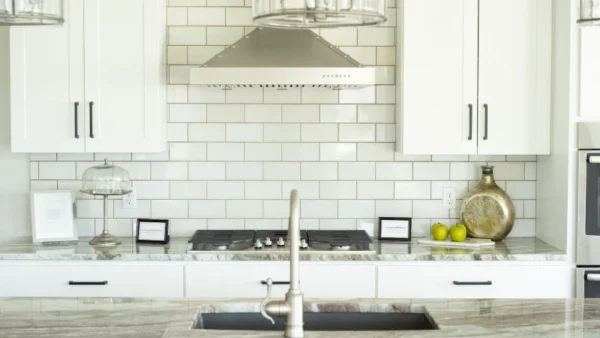Disclosure: This post may contain affiliate links, meaning we get a commission if you decide to make a purchase through our links, at no cost to you. Please read our disclosure for more info.
Last Updated on June 7, 2024 by Steal the Style
As a classic material, subway tile can stand the test of time. But the design and layout decide if it will feel timeless or dated.
Try arranging your tile in a stacked bond instead of the classic vertical style for a fresh look. Black grout lines also help create a dramatic effect in a kitchen backsplash.
Beveled Edge
Many homeowners want a different look than the traditional straight-edge subway tiles. Many vendors now offer beveled subway tile backsplashes to fit these needs.
Beveled tiles give your backsplash a three-dimensional look to create visual interest and movement in the design. They are especially useful when used in a dark grout color. They can also help to hide any imperfections in your grout lines.
Gray is a versatile shade that works well in modern and traditional kitchens. It can convey a sense of distance or seriousness when paired with white cabinets but also build a warm ambiance when used with timber and terracotta cabinets.
Beveled subway tile can also be used in a herringbone layout to distinguish the stove zone and provide a framed effect. This design will add an elegant accent to any kitchen.
Black
While white subway tile may be the classic choice, other colors and patterns can add a touch of boldness to your kitchen. Black is one of the most popular choices. It creates a striking modern look that can be used in traditional and contemporary kitchens.
Try the classic herringbone pattern rotated 90 degrees if you want something more unique. This twist on the classic subway tile pattern helps enlarge your space and draws the eye up, which can be helpful in a tall kitchen or bathroom. It also works well behind a kitchen sink or as a surround shower design.
Vertical
Staggering your tiles vertically instead of the traditional horizontal layout offers a sleek grid pattern that complements minimalist or clutter-core home designs.
Changing up the grout color also gives your subway backsplash a modern twist. A dark grout makes the backsplash pop and draws the eye upward, elongating tight spaces.
Gray tile adds more drama to the space and doesn’t show stains as quickly as white. It’s a great way to bring color into a kitchen with neutral cabinets.
Horizontal
Stacking subway tiles horizontally can be a great way to make an impact in smaller spaces. It can also help lean a transitional or traditional kitchen toward a contemporary style.
Try using a light-colored grout to minimize contrast and let the lines in the tile stand out. This allows the beauty of the tile to shine through and makes it easy to clean.
Shake up the stacked pattern by alternating tiles vertically instead of horizontally. This is a great option for small bathrooms because it helps to expand the space visually. It can also highlight a focal point, such as a stove or a piece of art.
Porcelain
Porcelain tiles have become increasingly popular in homes because of their durability, timeless aesthetic, and relatively low price. They are also nonabsorbent and stain-resistant, making them ideal for kitchen backsplashes and bathrooms exposed to moisture.
Ceramic tile is another affordable option miming natural materials like wood and stone. It can be glazed in various colors and finishes, including glossy and matte options that look great with modern styles.
If you want to add more color to your kitchen backsplash, porcelain subway tile is a great choice. It is available in a wide variety of hues that can coordinate with traditional, rustic, or even Mediterranean design schemes. Mix it with a contrasting grout color for a bold statement, or go neutral and subtle with a matching one to up the classic factor.
Glazes
When designing a kitchen, knowing how different finishes will look together is important. This is especially true for a traditional kitchen that will be part of a modern home. A design specialist can help you find a style that works for your space and home.
In a traditional kitchen, glazes are an easy way to add design elements without overstating the look. Glazes can be warm or cool depending on how they are applied, and a specialist can help you determine what looks best with your existing kitchen.
Muddier, desaturated colors complement a traditional kitchen’s neutral color palette. A backsplash incorporating specialty tile shapes like the arabesque pattern in this kitchen can be a focal point and create visual interest. It’s also a great way to showcase a glaze’s wide-ranging color variation.
Grout
The color of grout can dramatically change the look of subway tile. White, pencil-thin grout makes subway tiles look clean and classic, while darker grout accentuates the lines between each tile for a bolder aesthetic.
Beyond basic colors, there are countless ways to lay out your tile and create a custom look for your kitchen or bathroom. A simple running bond pattern is timeless and easy to implement, but you can also try a herringbone or vertical layout for something more unique.
Subway tiles grew in popularity when used in New York City subway stations in the early 1900s, but today, their sleek finish and ease of cleaning make them a practical choice for hardworking spaces like laundry rooms and mudrooms. Explore the different styles of subway tile and how to lay it out to find your favorite design.

